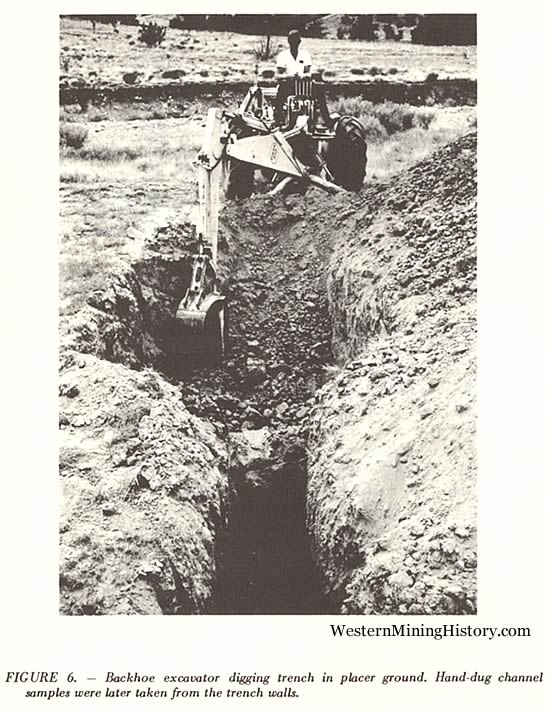-
d. Backhoe excavators: The development of compact, tractor-mounted backhoe excavators in recent years has given the mineral examiner a tool which adapts well to many of his placer sampling needs. These go-anywhere, high-performance machines dig, load and backfill. The combination most frequently employed is a hydraulically-operated backhoe unit mounted on the back end of a rubber-tired tractor plus a scraper or loading bucket at the front end. See Figure 6. A typical rig will ilig 10 feet deep, reach more than 15 feet from the pivot point and will load into a truck 11 feet high. The backhoe bucket has more than 7,000 pounds digging force and generates a pryout force of 15,000 pounds or more. Most placer ground is handled with ease. A 1.5 yard, track-mounted backhoe (Thew-Lorain) has a depth capacity of 27 feet and is available with a range of buckets that provide cutting widths from 12 to 38 inches.

In most areas, this type of equipment is available on a rental basis from contractors who will be found listed in the yellow pages of the telephone book under "excavating contractors." Rental rates vary with locality and machine size but $10 to $14 per hour is not unusual. This price includes the operator. On short-term jobs the charge starts at the time the equipment leaves the contractor's yard so it is well to have the work well planned and laid out in advance.
In connection with a placer sampling job near Grants Pass, Oregon, in 1966, thirteen shafts ranging from 4 to 12 feet deep were dug using a tractor-mounted backhoe equipped wi,th a 38-inch "graveyard" bucket. The backhoe with operator rented for $11 per hour. The 13 shafts were dug in 6 hours and the travel time was two hours bringing the total charge to $88. This amounted to a little less than $1 per foot of shaft and provides a good example of the cost and work accomplishment that can be expected when using this type of machine.
In most placer gravels the walls of backhoe-dug pits or trenches stand well and can be sampled by cutting a vertical channel in the face of the standing material. Depending on requirements and conditions, the sample channel can be cut with the backhoe bucket (usually 24" wide) or by hand. Where the presence of much large rock or ravelling ground precludes the use of channel cuts, either all excavated material or alternate buckets can be set aside as a bulk sample. See Table III, p. 99. The tractor-mounted backhoe is probably the most versatile placer sampling tool available to the mineral examiner today.